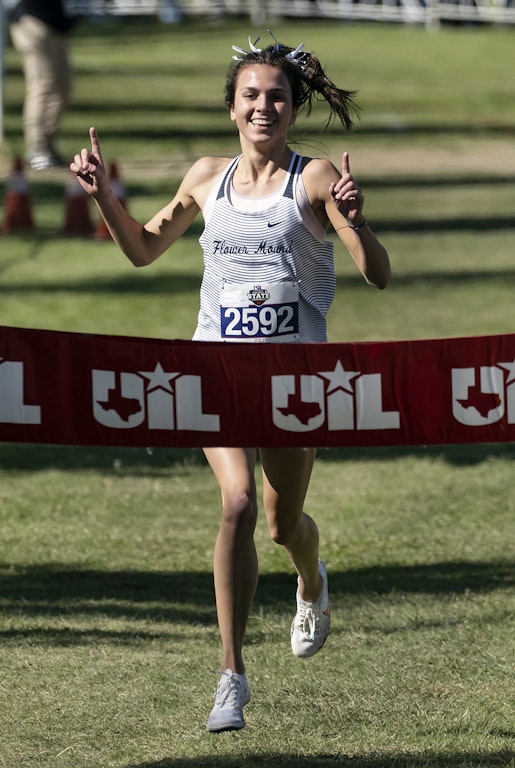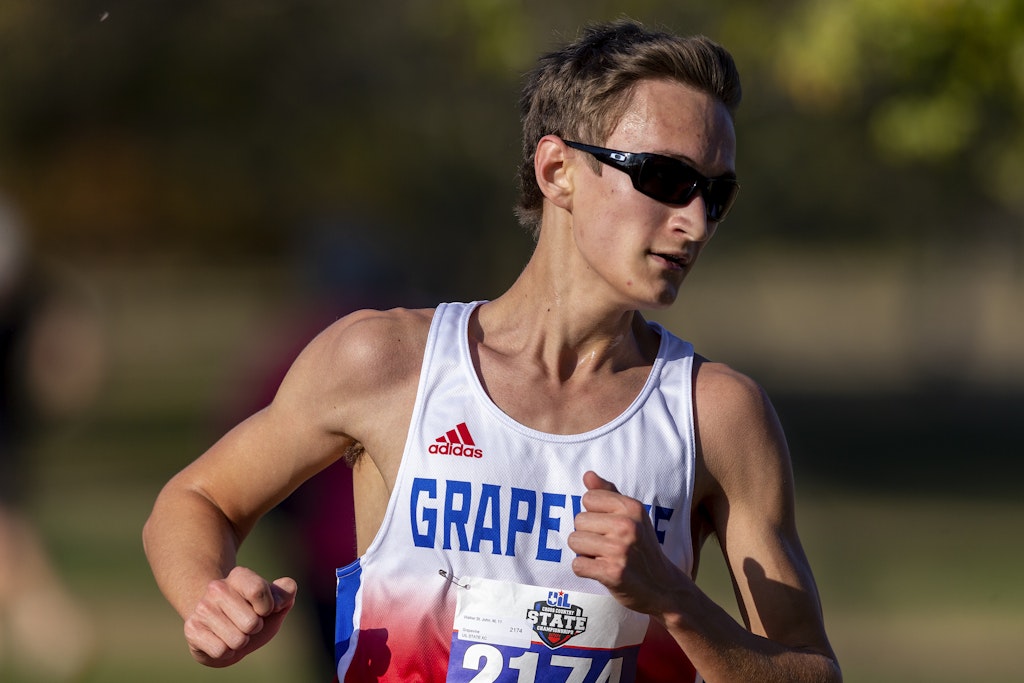
Flower Mound wunderkind Natalie Cook has taken an unconventional path to becoming one of the fastest distance runners in the world as a high school senior. That includes her unique training program.
When she does workouts on the track, it is almost always with boys. But for her most extraordinary workout, the Oklahoma State signee trained with her dad early last week.
Cook ran by herself on the track while her father, Andrew Cook, rode his bike next to her. As he rode, the Flower Mound coach played music from his daughter’s playlist — a lot of alternative rock — to inspire her as she ran a mile, then two miles, then another mile, with only a minute or two of rest between each one.
Her times were 5:00, 10:05 and 5:00. This was just a training session, but Cook’s 3,200-meter split was nearly as fast as the UIL state-meet record of 9:58.77.
“I felt really good during that workout, but it’s usually considered one of the hardest workouts,” she said. “I don’t really like speed workouts that much. I enjoy longer stuff.”
That was Cook’s last workout before Friday’s Stanford Invitational, where she broke the high school national record and the American under-20 record in the girls 5,000 by running 15:25.93. She finished third in a race that included pro and college athletes.
The 18-year-old’s time was nearly three seconds faster than the winning time at last year’s NCAA outdoor national championships, and it is the 12th-best outdoor time in the world in 2022, according to World Athletics. Cook is only 19 seconds behind the world leader, Olympian and former NCAA 1,500-meter champion Jessica Hull from Australia.
Showing that it is much more than just a football state, Texas has 14 individuals/relay teams ranked No. 1 in the nation this season, according to MileSplit. That includes three individuals and four relays from the Dallas area.
The common thread is that they have found workout plans that work for them, even if some aren’t traditional high school training regimens.
Natalie Cook
Cook ran 10:32.92 in the 3,200 at last year’s state meet, finishing fourth, then 10 months later ran the second-fastest high school indoor two-mile time — 9:44.44 — in U.S. history. The secret to her dramatic improvement?
Running low mileage and doing cross training on an elliptical machine to keep her healthy after she took about a year off from running after her sophomore cross country season because of a navicular stress fracture in her foot.
“I used to do high mileage, and that didn’t work out, so supplementing cross training has helped a lot. I do that on hard days and Sundays,” she said.
Flower Mound broke the national record in the indoor 4x1-mile relay and smashed the state record in the 4x800 relay, but the girls on those relays — Cook, senior Virginia Knight, sophomores Nicole Humphries and Samantha Humphries and freshman Alexandra Fox — don’t always work out together because each of them has an individualized training plan that factors in how they are feeling each day. Cook’s week may include a track workout such as a four-mile tempo run or mile repeats, and then just easy runs in the neighborhood.
“She doesn’t run on Wednesdays or Sundays. She usually works out hard once a week and then has a race,” Andrew Cook said. “I think she has maxed out at like 22 miles for the week, and that’s really low. I would say the rest of our girls are probably in that 30 to 40 range.”
Cook’s goals for the rest of this season are to run under 4:40 in the 1,600 and to run 9:40 to 9:45 in the 3,200. The 3,200 national record for high school-only competitions, as recognized by the National Federation of State High School Associations, is 9:47.88.
Walker St. John
Grapevine’s Walker St. John takes a different approach than Cook and runs up to 50 to 55 miles a week. The North Carolina signee ran on the distance medley relay that has the No. 1 time in the nation (10:15.48), and he ranks No. 4 in the U.S. in the 3,200 (8:57.77) and No. 9 in the 1,600 (4:09.24).
St. John runs 13 miles each Monday, Tuesday is a hard interval day (such as six to 10 800s and then some 200s), Wednesday is a recovery run (typically six miles), and Thursday may consist of four to six miles that are each run about 1 minute, 20 seconds above mile race pace. Grapevine backs off on its training before big meets, taking an extra day or two for recovery, and its work off the track is vital.
“I think the thing that has really made our team improve a lot has really been the hill strides on Tuesdays,” St. John said. “After the fast workouts, we’ll have a recovery run in the afternoon and then some optional hill strides. I think that has really been the main secret.”
Duncanville’s relays
Duncanville has the nation’s No. 1 boys 4x200 relay team at 1:24.16, and its 4x100 relay ranks No. 2 nationally at 40.28. Coach Clayton Brookins has his sprinters follow a training plan used by many colleges, so workouts before the postseason arrives include flying 30s, flying 60s and in-and-out 90 meters — focusing on short bursts of maximum-velocity speed — or 150- and 250-meter intervals.
“It’s transition work, trying to get the body to get to where you’re running a certain speed and the body gets comfortable with that speed,” Brookins said. “In and out is you accelerate, you step on the gas for a certain distance, 10 to 15 meters, and then you kind of back off, then you hit it again, and then back off. We do the in and outs to kind of break that barrier and try to take it to the next level.”
Most of Duncanville’s top sprinters played football in the fall, so they came into track season in great shape, and Duncanville thinks it can challenge national records in the 4x100 (39.76) and 4x200 (1:23.25). Three football players — Sam Houston State signee Chris Hicks Jr., SMU signee Pierre Goree and Jaylen Washington — joined Houston track signee Donte’ Hamilton on the 4x200 relay that ran the nation’s best time at the Texas Relays.
Claire Lowrey
Rockwall junior high jumper Claire Lowrey has reached new heights in 2022, going from a PR of 5-8
She has been helped by playing a second sport, volleyball.
“There is no telling how many times she is jumping in a single practice,” said Toby Howell, who coaches Rockwall’s high jumpers. “It provides her great training in the offseason to prepare for track season.”
Howell thinks Lowrey has a shot at the state-meet record of 6-2 that is held by five-time Olympian Amy Acuff. Lowrey spends one to two days a week working on technique and another day jumping for height, but it’s a different practice routine that has given her the feeling of jumping higher than Acuff’s record.
“Without adrenaline, it’s really hard to jump at your PR [in practice],” Howell said. “The thing I do to help that is to jump off a box. She’s jumping 5-8, but still getting the sensation of jumping a 6-3 or 6-4 jump.”
Howell has also been able to impart the knowledge that he learned from 1988 Olympic high jump gold medalist Louise Ritter, who taught him how to high jump during summer track when he was in elementary school.
Twitter: @DMNGregRiddle
